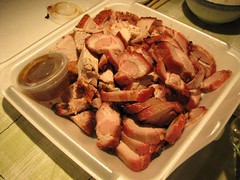Montreal Chinatown: an hour of food
After work, I bussed down to Chinatown to pick up dinner for tonight. In about less than an hour, I walked around the quarter, and here's a summary of what I found out, or found was worth blogging about.
Cured duck leg
Cured duck leg hangs at the window of Sun Sing Lung, on De La Gauchetière, below Keung Kee restaurant, near Clark and St-Urbain. It sells for $9 a pound, and the leg piece I had cost $3.45. Cured duck leg, also called "air-dried duck leg" (or "lap ap pei" in Cantonese) is typically cooked in the rice cooker, so that the juices are absorbed by the rice. In restaurants, the rice cooker is substituted with an earthenware pot, and Chinese bacon, salted eggs and Chinese lap cheung may be added as well. This is generally called "lap mei faan", which is loosely translated as tasty rice. It is indeed very tasty.
HK-style milk tea
 HK-style milk tea is a metaphor for its namesake: it is a very strong Chinese tea, mixed with evaporated milk, like the Brits do. The concoction should be as bitter as coffee, and yet keeps the smoothness of its lactic parent. Authentic milk tea can't be gotten anywhere (at least in Montreal), because not all Chinese restaurants keep strong tea, let alone evaporated milk. In Chinatown, there are two places that I know which serves the real thing, both being two of Chinatown's "cha chaan teng", or tea eateries: the Unnamed Eatery Under Kam Fung (on St-Urbain, below René-Lévesque, and facing Complexe Guy-Favreau), and Legend ("Lai Tsing") on De La Gauchetière, between Clark and St-Urbain. Milk tea at bubble tea places like L2 and Magic Idea are too diluted to be considered HK-style milk tea.
HK-style milk tea is a metaphor for its namesake: it is a very strong Chinese tea, mixed with evaporated milk, like the Brits do. The concoction should be as bitter as coffee, and yet keeps the smoothness of its lactic parent. Authentic milk tea can't be gotten anywhere (at least in Montreal), because not all Chinese restaurants keep strong tea, let alone evaporated milk. In Chinatown, there are two places that I know which serves the real thing, both being two of Chinatown's "cha chaan teng", or tea eateries: the Unnamed Eatery Under Kam Fung (on St-Urbain, below René-Lévesque, and facing Complexe Guy-Favreau), and Legend ("Lai Tsing") on De La Gauchetière, between Clark and St-Urbain. Milk tea at bubble tea places like L2 and Magic Idea are too diluted to be considered HK-style milk tea.
Chinese BBQ (to go)
It's meat, after all, and not really the kind that you soak up with saline water or gelatin to increase its weight. "Siu yok" is roasted pork. The best cut arguably traverse the ribs, as it is leanest (as you get real meat, you also get a lot of real lard). Two rib bones should be enough to feed 3-4 hungry people, and I got mine for $9.50 at Restaurant Hong Kong, on the east side of St-Laurent, below De La Gauchetière, in that cavern-like shopping mall. Other tenants there have changed hands at least three or four times each since my childhood, from fishmonger to Korean restaurants, while Restaurant Hong Kong stood there for over fifteen years. They are especially good for their char siu (Barbecued pork filet, and a semi-fat piece is good - for $5 a strip). Either have it chopped up in front of you, if you're planning to eat it the same night, or not, if you wish to eat it another day and preserve the meat's moisture (can be frozen and thawed in a bowl of hot instant noodles). For the same day, the best is to not heat it up in the oven, such that the pieces' don't become dry and gelatinous.Generally, people prefer to eat it on rice with veggies, but it can also be served in noodles, or in a stir fry (where siu yok loses its crunch, and char siu, its flavour, however). My father thinks that the Chinese meat place under Kam Fung restaurant is also great for its siu yok, but not the rest.
Chinese green vegetable
You can buy Chinese greens, or "choy", about anywhere. "Bok choy", or White Vegetable, can mean a lot of things. It typically points to the Chinese cabbage, or Nappa, which is the same that is used by Koreans for kimchi. The variety pictured here is a lot different, but also called "bok choy", and more specifically "Shanghai baby bok choy". They are bulb-shaped, bright green upon cooking and bite-sized (the ones slightly bigger ones drop the "baby").Prices vary depending on the season, and they now currently fetch for $2.69/lbs, a big pack for four people costs $4.25. I like going to the grocery store "Wing Cheong Hong" that opened in '05 on Clark, in the Ruby Rouge shopping mall, and with a door on the street too, because they are the only grocery store in Chinatown with a vegetable counter. The vegetable counter is just a table in the front store where the employees open up boxes of vegetable and pack them in transparent plastic bags in front of customers. It's a common practice in supermarkets in Asia and in Chinese Canadian supermarkets, like T&T and Hawai, but the concept still doesn't register with many older grocery stores.
Cooking SH baby bok choy well is art. Prepare about a garlic clove per person. I prefer finely chopping my garlic, as I think the flavour releases more evenly. You must heat up a fair amount of oil in a wok. The oil's the key to cooking good bok choy: the vegetable must be crunchy, yet cooked. The hot cooking oil rapidly transfers its heat to the vegetable, cooking it quickly and thoroughly. If the oil's not hot enough, then it extends the cooking for too long, and the choy become soggy. The other requirement is for vigorous stirring, or otherwise, the vegetable won't cook evenly, and you will end up with the inside of your bok choy left uncooked. Throw in the chopped garlic on the nearly-smoking cooking oil, but don't let it brown, or you will be stuck with a bitter garlic aftertaste. Then, throw in full baby bok choy, and fry while stirring well, until you get the consistency that you want (slightly more raw is better, because it will cook some more at rest, in the presentation vessel).


Don't forget the great dim sums of China Town. The Chinese BBQ you mentionned are indeed awesome.
Montreal Chinatown seems the right place to be for having the taste of the good chinese cuisine. It was the discussion of a frien of mine last time, how chinese innovated the art of cuisine through their means of cooking food. Very traditional and unique.
mutuelle santé